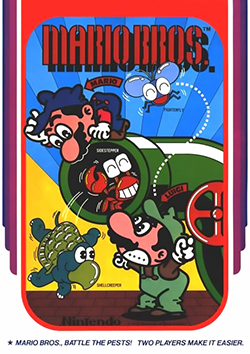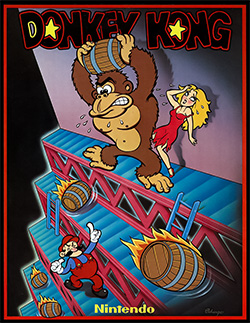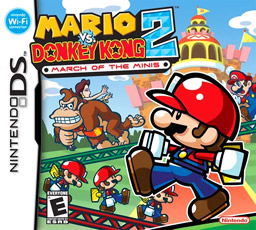
Dr. Mario is a 1990 puzzle video game developed and published by Nintendo for the Nintendo Entertainment System, Famicom, and Game Boy. It was produced by Gunpei Yokoi and designed by Takahiro Harada. The soundtrack was composed by Hirokazu Tanaka.

Mario Bros. is a platform game developed and published by Nintendo as an arcade video game in 1983. It was designed by Shigeru Miyamoto and Gunpei Yokoi, Nintendo's chief engineer. Italian twin brother plumbers Mario and Luigi exterminate creatures, like turtles (Koopas) and crabs emerging from the sewers by knocking them upside-down and kicking them away. The Famicom/Nintendo Entertainment System version is the first game produced by Intelligent Systems. It is part of the Mario franchise, but originally began as a spin-off from the Donkey Kong series.

Super Mario World 2: Yoshi's Island is a 1995 platform game developed and published by Nintendo for the Super Nintendo Entertainment System (SNES). It is the sequel follow-up to Super Mario World. The player controls Yoshi, a friendly dinosaur, on a quest to reunite baby Mario with his brother Luigi, who has been kidnapped by Kamek. As a Super Mario series platformer, Yoshi runs and jumps to reach the end of the level while solving puzzles and collecting items with Mario's help. The game has a hand-drawn aesthetic and was the first in the franchise to have Yoshi as its main character, where it introduces his signature flutter jump and egg spawning abilities.

Mario Tennis is a 2000 sports video game developed by Camelot Software Planning and published by Nintendo for the Nintendo 64. Following Mario's Tennis, it is the second game in the Mario Tennis series. The game is known for being the introduction of Luigi's arch-rival, Waluigi, and the re-introduction of Princess Daisy and Birdo.

The Nintendo e-Reader, commonly abbreviated as e-Reader, is an add-on manufactured by Nintendo for its Game Boy Advance handheld video game console. It was released in Japan in December 2001, with a North American release following in September 2002. It has an LED scanner that reads "e-Reader cards", paper cards with specially encoded data printed on them.

Donkey Kong is a 1981 arcade video game developed and published by Nintendo. As Mario, the player runs and jumps on platforms and climbs ladders to ascend a construction site and rescue Pauline from a giant gorilla, the titular Donkey Kong. It is the first game in the Donkey Kong series as well as Mario's first appearance in a video game.

Donkey Kong, also referred to as Donkey Kong '94, is a 1994 puzzle-platform game developed by Nintendo and Pax Softnica and published by Nintendo for the Game Boy. Donkey Kong is loosely based on the 1981 arcade game of the same name and its sequel Donkey Kong Jr.

Mario vs. Donkey Kong 2: March of the Minis is a 2006 puzzle-platform game developed by Nintendo Software Technology for the Nintendo DS. Serving as a direct sequel to the Game Boy Advance game Mario vs. Donkey Kong, the gameplay involves the player guiding several Mini Marios through platform stages with the touch screen as they attempt to defeat Donkey Kong. The game also marks the return of Pauline, who had not been seen since 1994's Donkey Kong.
Donkey Kong is a video game series and media franchise created by the Japanese game designer Shigeru Miyamoto for Nintendo. The franchise follows the adventures of Donkey Kong, a large, powerful gorilla. Donkey Kong series include the original arcade game trilogy by Nintendo R&D1; the Donkey Kong Country series by Rare and Retro Studios; and the Mario vs. Donkey Kong series by Nintendo Software Technology. Various studios have developed spin-offs in other genres such as edutainment, puzzle, racing, and rhythm. The franchise also incorporates animation, printed media, theme parks, and merchandise.

Mario is a Japanese multimedia franchise created by Japanese game designer Shigeru Miyamoto for video game company Nintendo, which produces and publishes its installments. Starring the titular Italian plumber Mario, it is primarily a video game franchise but has extended to other forms of media, including television series, comic books, a 1993 feature film, a 2023 animated film, and theme park attractions. The series' first installment was 1983's Mario Bros., although Mario made his first appearance in 1981's arcade game Donkey Kong and had already been featured in several games of the Donkey Kong and Game & Watch series. The Mario games have been developed by a wide variety of developers, including Nintendo, Hudson Soft, and AlphaDream. Mario games have been released almost exclusively for Nintendo's various video game consoles and handhelds, from the third generation onward.

Mario vs. Donkey Kong: Minis March Again! is a 2009 puzzle-platform game developed by Nintendo Software Technology for the Nintendo DSi. The third game in the Mario vs. Donkey Kong series, it is a follow-up to Mario vs. Donkey Kong 2: March of the Minis. It is the first DSiWare game to feature a level editor in which players can create custom-made levels and send them to players on other devices via a wireless Internet connection.

Mario vs. Donkey Kong: Mini-Land Mayhem! is a 2010 puzzle-platform game developed by Nintendo Software Technology for the Nintendo DS. The game was released in North America on November 14, 2010 and is the fourth entry in the Mario vs. Donkey Kong series.

Mario and Donkey Kong: Minis on the Move, known in Japan as Mario & Donkey Kong: MiniMini Carnival, is a 2013 puzzle game developed by Nintendo Software Technology for the Nintendo 3DS. The fifth entry in the Mario vs. Donkey Kong series, it was released exclusively via the Nintendo eShop download service on May 9, 2013, in the PAL region and North America, and on July 24 in Japan.

Donkey Kong Country: Tropical Freeze is a 2014 platform game developed by Retro Studios and published by Nintendo for the Wii U console. The fifth installment in the Donkey Kong Country series, Tropical Freeze is a direct sequel to the 2010 Wii game Donkey Kong Country Returns and was released in February 2014. An enhanced port for the Nintendo Switch was released in May 2018.

Mario vs. Donkey Kong is a puzzle-platform game series published by Nintendo. A spin-off of both the Mario and Donkey Kong franchises, the series marks the return of both Pauline and the rivalry between Mario and Donkey Kong.

Mario vs. Donkey Kong: Tipping Stars is a 2015 puzzle-platform game developed by Nintendo Software Technology and published by Nintendo for the Nintendo 3DS and Wii U. It is the sixth game in the Mario vs. Donkey Kong series and the 200th video game featuring Mario. The game was released worldwide in March 2015 on the Nintendo eShop for all regions, except in Japan. This is the first Nintendo-published title to support a cross-purchase concept, and the first Nintendo 3DS title to support Miiverse stamps. If players buy one version, they receive a free download code for the other version.


















